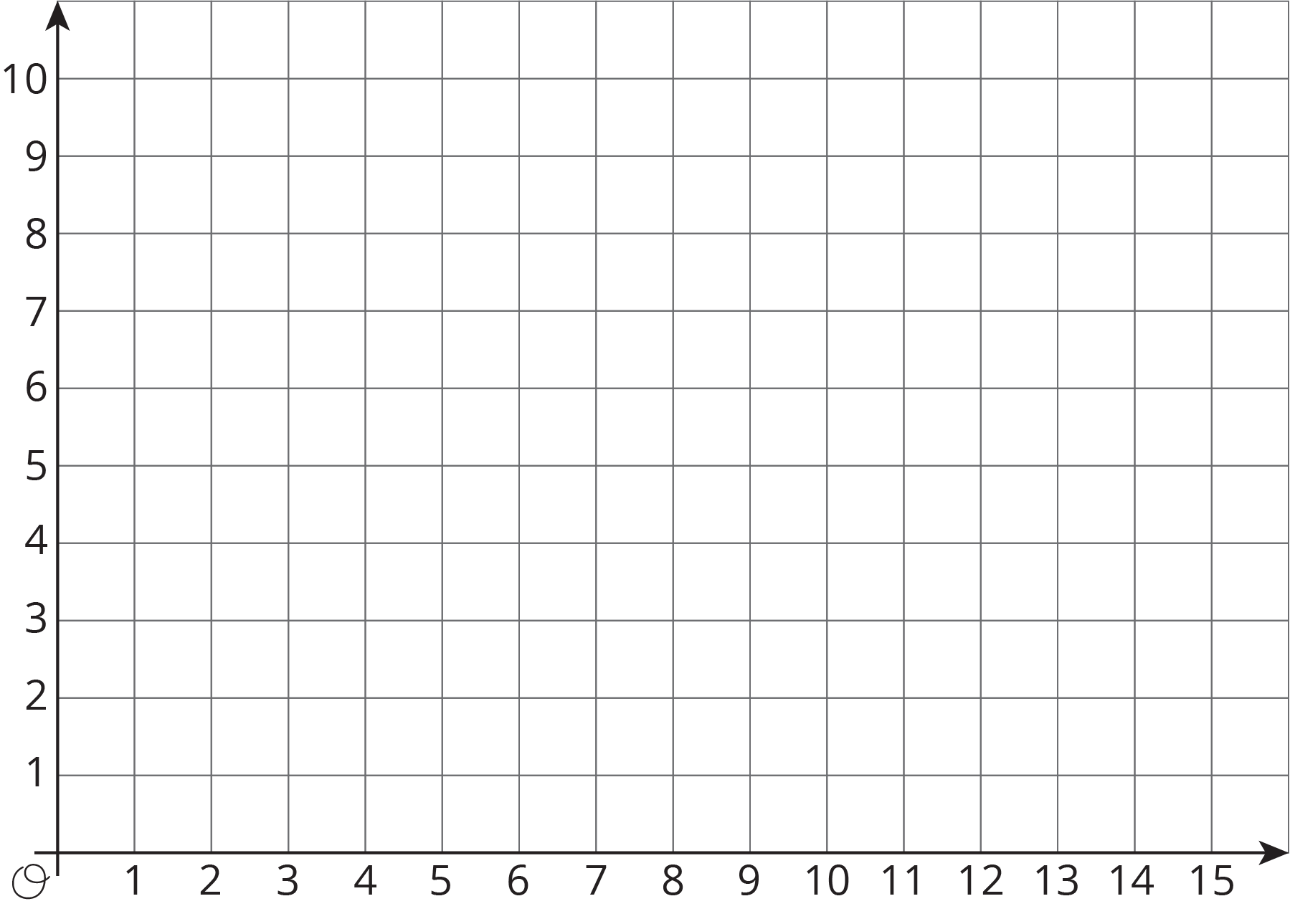Lesson 11
Constructing the Coordinate Plane
11.1: Guess My Line (10 minutes)
Warm-up
The purpose of this warm-up is for students to review graphing and locating points in the first quadrant of the coordinate plane. Students observe the structure of horizontal and vertical lines when they compare points on the same line and notice which coordinate of the ordered pair changes and why (MP7).
Launch
Arrange students in groups of 2. Display the coordinate plane for all to see and ask, "What do you notice about the plane? What do you wonder?" Invite a few students to share what they notice and wonder until a student has noticed there are no labels on the axes. Ask, "How should we label the axes?" Otherwise, point out that the axes aren't labeled and ask them how they should be labeled. This lesson plan refers to the axes and coordinates with the standard \(x\) and \(y\) variables. Invite a student to read the directions for both questions in the task. Once confident that groups understand the directions, give groups 4 minutes to guess each other's points followed by a whole-class discussion.
Student Facing
-
Choose a horizontal or a vertical line on the grid. Draw 4 points on the line and label each point with its coordinates.

-
Tell your partner whether your line is horizontal or vertical, and have your partner guess the locations of your points by naming coordinates.
If a guess is correct, put an X through the point. If your partner guessed a point that is on your line but not the point that you plotted, say, “That point is on my line, but is not one of my points.”
Take turns guessing each other’s points, 3 guesses per turn.
Student Response
For access, consult one of our IM Certified Partners.
Anticipated Misconceptions
Some students may not remember that the first coordinate in an ordered pair corresponds to the horizontal coordinate and the second coordinate in the ordered pair corresponds to the vertical coordinate. Display the ordered pair \((x,y)\) or \((\text{horizontal}, \text{vertical})\) to remind students of the order.
Activity Synthesis
The key takeaway of this discussion is that points on the same horizontal line share the same \(y\) coordinate and points on the same vertical line share the same \(x\) coordinate. Ask 3 or 4 students to share the coordinates of their 4 points. After each student shares, ask the rest of the class if the given points are on the same horizontal or vertical line and to explain how they know. To help guide the conversation, consider asking some of the following questions:
- “How do you know the points fall on the same line?”
- “How do you know the points are on a horizontal or vertical line?”
- “Could you name other points on the same line?”
- “How far is each of the points from one another?”
- “How far is each point from the \(x\)-axis and \(y\)-axis?”
11.2: The Coordinate Plane (15 minutes)
Activity
The purpose of this activity is for students to extend the vertical and horizontal axes to include 4 quadrants just as they extended the number line to include negative numbers. Students are introduced to the term quadrant. Students plot and label coordinates using ordered pairs and identify their quadrants.
Launch
Introduce the concept of the 4-region coordinate plane by explaining that, just like we extended the number line include negative numbers, we can extend both the number lines of the coordinate plane (the axes) to include negative coordinates. Use the word quadrant to describe the four regions of the coordinate plane. It may be helpful to explain that the prefix "quad-" means 4 and give other examples from English and other languages that use the prefix (quadriceps, quadrilateral, cuatro). Give students 10 minutes to work followed by whole-class discussion.
Classes using the digital version have an interactive applet to use. Instead of naming the coordinates, students enter them into the Input Bar. If correct, the new points will hit the targets and turn them black.
Supports accessibility for: Conceptual processing; Language
Student Facing
-

- What do you notice about the locations and ordered pairs of \(B\), \(C\), and \(D\)? How are they different from those for point \(A\)?
-
Plot a point at \((\text-2, 5)\). Label it \(E\). Plot another point at \((3, \text-4.5)\). Label it \(F\).
- The coordinate plane is divided into four quadrants, I, II, III, and IV, as shown here.

- \(G = (5, 2)\)
- \(H=(\text-1, \text-5)\)
- \(I=(7,\text-4)\)
- In which quadrant is \(G\) located? \(H\)? \(I\)?
- A point has a positive \(y\)-coordinate. In which quadrant could it be?
Student Response
For access, consult one of our IM Certified Partners.
Launch
Introduce the concept of the 4-region coordinate plane by explaining that, just like we extended the number line include negative numbers, we can extend both the number lines of the coordinate plane (the axes) to include negative coordinates. Use the word quadrant to describe the four regions of the coordinate plane. It may be helpful to explain that the prefix "quad-" means 4 and give other examples from English and other languages that use the prefix (quadriceps, quadrilateral, cuatro). Give students 10 minutes to work followed by whole-class discussion.
Classes using the digital version have an interactive applet to use. Instead of naming the coordinates, students enter them into the Input Bar. If correct, the new points will hit the targets and turn them black.
Supports accessibility for: Conceptual processing; Language
Student Facing
-
Label each point on the coordinate plane with an ordered pair.

- What do you notice about the locations and ordered pairs of \(B\), \(C\), and \(D\)? How are they different from those for point \(A\)?
- Plot a point at \((\text-2, 5)\). Label it \(E\). Plot another point at \((3, \text-4.5)\). Label it \(F\).
-
The coordinate plane is divided into four quadrants, I, II, III, and IV, as shown here.

\(G = (5, 2)\)
\(H=(\text-1, \text-5)\)
\(I=(7,\text-4)\)
- In which quadrant is point \(G\) located? Point \(H\)? Point \(I\)?
- A point has a positive \(y\)-coordinate. In which quadrant could it be?
Student Response
For access, consult one of our IM Certified Partners.
Anticipated Misconceptions
Students may confuse the order of the coordinate pairs when plotting points. Direct students to look at their work with vertical and horizontal lines in the warm up to remind them which coordinate is vertical.
Students may locate -4.5 between -3 and -4, rather than between -4 and -5. Direct them to the number lines used in earlier lessons to remind them of locating non integer numbers on number lines.
Activity Synthesis
The most important idea for students to understand is that by extending the two number lines that form the coordinate axes for the first quadrant, we now have 4 quadrants. We describe points in these quadrants using negative and positive numbers as the \(x\) and \(y\) coordinates. Focus on responses from question 4 for discussion. Invite students to share their reasoning about how to identify the quadrants for the points \(G\), \(H\), and \(I\). As time allows, consider asking the following questions:
- “If a point has a negative \(x\)-coordinate, what quadrant could it be in?”
- “If a point has a negative \(y\)-coordinate, what quadrant could it be in?”
- “If a point has a positive \(x\)-coordinate, what quadrant could it be in?”
To involve more students in the conversation, consider asking:
- “Do you agree or disagree? Why?”
- “Who can restate ___’s reasoning in a different way?”
- “Does anyone want to add on to _____’s reasoning?”
Design Principle(s): Support sense-making
11.3: Axes Drawing Decisions (25 minutes)
Activity
The purpose of this activity is for students to draw their own axes for different sets of coordinates. They must decide which of the four quadrants they need to use and how to scale the axes. Some students may use logic such as “the largest/smallest point is this, so my axes must go at least that far.” Identify these strategies for the discussion. Monitor for differences in scales and axes where the points were still able to be plotted correctly to highlight during discussion.
Launch
Arrange students in groups of 2. Allow 10 minutes for students to construct their graphs and discuss them with their partners. Follow with a whole-class discussion.
Supports accessibility for: Memory; Organization
Design Principle(s): Maximize meta-awareness
Student Facing
-
Here are three sets of coordinates. For each set, draw and label an appropriate pair of axes and plot the points.
-
\((1, 2), (3, \text-4), (\text-5, \text-2), (0, 2.5)\)

-
\((50, 50), (0, 0), (\text-10, \text-30), (\text-35, 40)\)

-
\(\left(\frac14, \frac34\right), \left(\frac {\text{-}5}{4}, \frac12\right), \left(\text-1\frac14, \frac {\text{-}3}{4}\right), \left(\frac14, \frac {\text{-}1}{2}\right)\)

-
-
Discuss with a partner:
- How are the axes and labels of your three drawings different?
- How did the coordinates affect the way you drew the axes and label the numbers?
Student Response
For access, consult one of our IM Certified Partners.
Anticipated Misconceptions
Make sure that students label distances on their axes consistently. For example, if the first tick mark after 0 is 3, then the next must be 6 in order for the spacing to be consistent.
Activity Synthesis
The key takeaway from this discussion is that defining axes and scale is a process of reasoning, not an exact science. Ask students to share their strategies about how to place and scale their axes. First, display previously selected student responses that capture the same data on their axes, but with slightly different origins or scales. Ask students which axes they think better represent the data. If not mentioned by students, point out that axes with a lot of empty space probably could benefit from either a different scale or a different origin. Select previously identified students to demonstrate a reliable strategy for finding the needed maximum or minimum. Link back to the warm-up when talking about how to scale the axes: if there are larger numbers, then a bigger scale makes more sense. Also draw attention to the fractional coordinates and how using decimal equivalents might make it easier to scale.
Lesson Synthesis
Lesson Synthesis
In this lesson, students extended the axes of the coordinate plane to include negative coordinates. Consider asking students the following questions to summarize the main ideas of the lesson:
- What are the names of the quadrants and where are they in the coordinate plane? (The quadrants are called I, II, III, and IV. They go in counterclockwise order from top right to top left to bottom left to bottom right.)
- What quadrant is the point \((\text-4, 5)\) in? How do you know? (That point is in quadrant II. The \(x\)-value is negative, so the point is left of the \(y\)-axis, and the \(y\)-value is positive so the point is above the \(x\)-axis.)
- What quadrant is the point \((5, \text-4)\) in? How do you know? (That point is in quadrant IV. The \(x\)-value is positive, so the point is right of the \(y\)-axis, and the \(y\)-value is negative, so the point is below the \(x\)-axis.)
11.4: Cool-down - What Went Wrong: Graphing Edition (5 minutes)
Cool-Down
For access, consult one of our IM Certified Partners.
Student Lesson Summary
Student Facing
Just as the number line can be extended to the left to include negative numbers, the \(x\)- and \(y\)-axis of a coordinate plane can also be extended to include negative values.

The ordered pair \((x,y)\) can have negative \(x\)- and \(y\)-values. For \(B= (\text-4,1)\), the \(x\)-value of -4 tells us that the point is 4 units to the left of the \(y\)-axis. The \(y\)-value of 1 tells us that the point is one unit above the \(x\)-axis.
The same reasoning applies to the points \(A\) and \(C\). The \(x\)- and \(y\)-coordinates for point \(A\) are positive, so \(A\) is to the right of the \(y\)-axis and above the \(x\)-axis. The \(x\)- and \(y\)-coordinates for point \(C\) are negative, so \(C\) is to the left of the \(y\)-axis and below the \(x\)-axis.